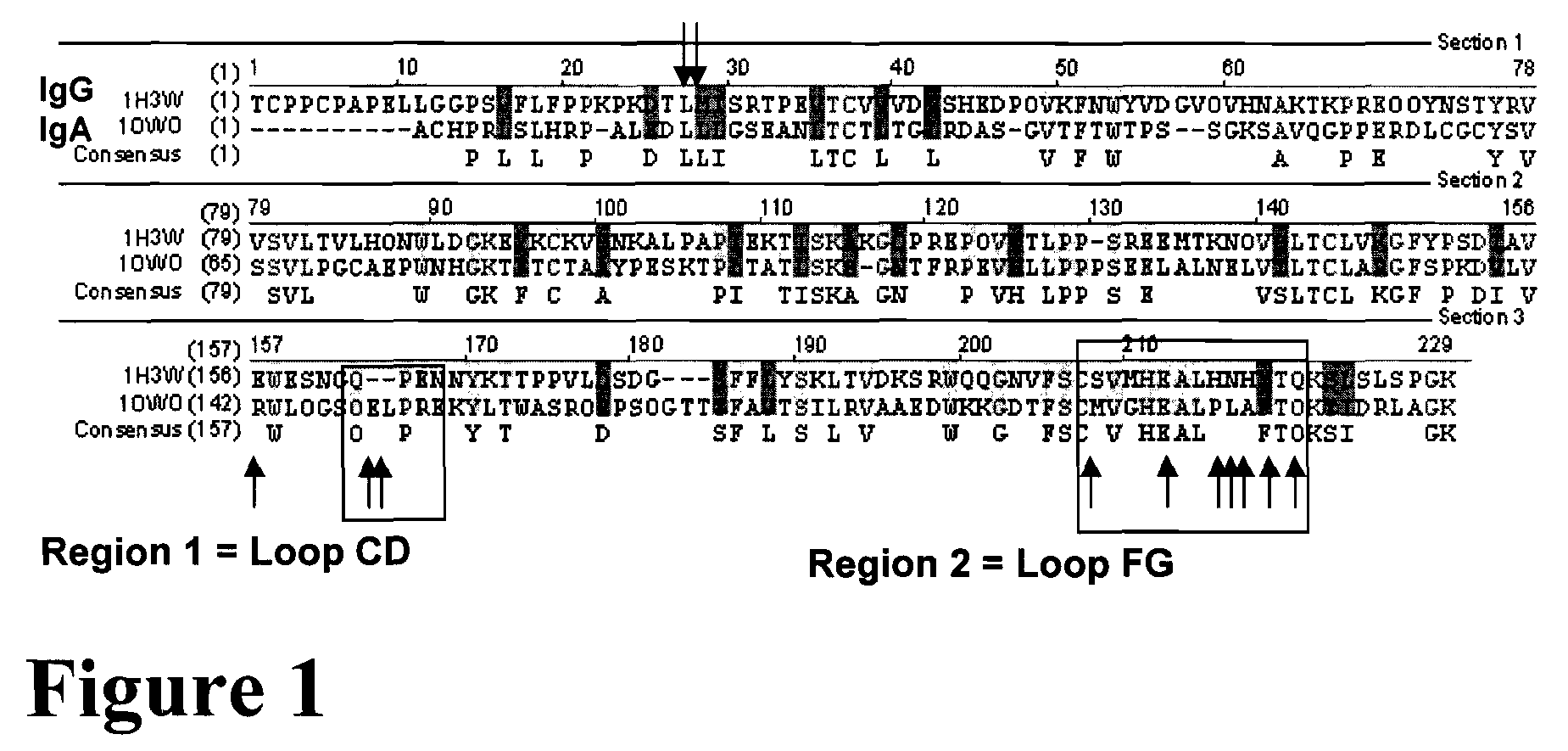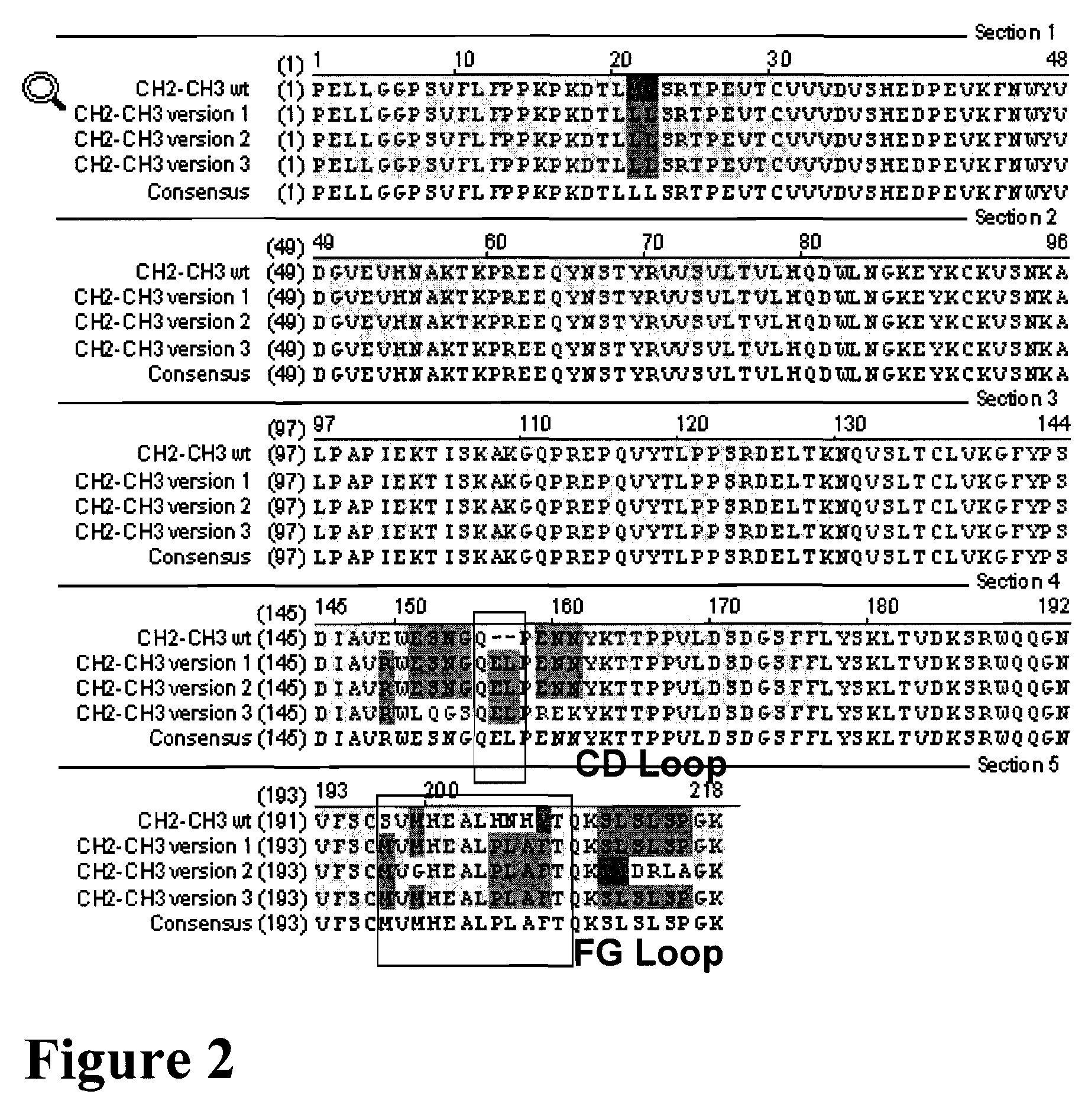Binding proteins comprising immunoglobulin hinge and fc regions having altered fc effector functions
a technology of binding proteins and effector functions, which is applied in the field of immunoglobulins, protein chemistry, molecular biology, can solve the problems of preventing the delivery of a minimum effective dose to the target tissue, unable to manufacture adequate amounts of scfv for patients, and unable to stabilize scfv molecules, etc., to achieve the effect of modifying binding affinity and/or specificity
- Summary
- Abstract
- Description
- Claims
- Application Information
AI Technical Summary
Problems solved by technology
Method used
Image
Examples
example 1
Modification of Loops within an Igg Immunoglobulin Hinge and / or CH2 Domains Confers Improved FcRγIII Binding Affinity
[0186]Member of the IgG class of antibodies specifically bind to CD16 (FcRγIII). Mutational changes within loop domains of an exemplary IgG antibody were constructed to alter the binding affinity of IgG for its cognate Fc receptor CD16. Specifically targeted were the four loops of the CH2 IgG domains that contact the CD16 molecule at two interfaces. Based upon the crystal structure described by Sondermann P. et al., Nature 406(6793):267-73 (2000), a first interface involves the interaction of CD16 with a hinge region loop and the FG loop of the alpha chain of CH2. A second interface involves an interaction of the CD16 molecule with the hinge region loop, BC loop, DE loop (i.e. a carbohydrate loop), and the FG loop of the beta chain of CH2. See FIG. 1 for a diagram of these contact sites.
[0187]Insertion mutagenesis was employed to generate changes at the two interfaces...
example 2
Modification of Loops within an IgG Immunoglobulin CH3 Domain Confers Unique Binding Specificities
[0195]This Example discloses exemplary modifications within the IgG CH3 region that provide new, non-native recognition surfaces and, hence, binding specificities.
[0196]Several loops within the CH3 domain of IgG were engineered to provide IgA-specific binding interactions (referred to herein as IgG / A loopers). Expression of the following three IgG / A looper constructs were made and expressed in Cos cells: (a) IgG amino acids within the IgG CH3 domain were replaced with amino acids from the IgA CH3 domain, which amino acids in the wild-type IgA immunoglobulin directly contact the Fcα-receptor (i.e. CD89), as well as two additional amino acids within the CD loop; (b) IgG amino acids within the IgG CH3 FG loop domain were replaced with amino acids from the IgA CH3 FG loop domain as well as other amino acids that contact the Fcα-receptor; and (c) IgG amino acids within the IgG CH3 CD loop do...
PUM
| Property | Measurement | Unit |
|---|---|---|
| pH | aaaaa | aaaaa |
| concentration | aaaaa | aaaaa |
| binding affinity | aaaaa | aaaaa |
Abstract
Description
Claims
Application Information
 Login to View More
Login to View More - R&D
- Intellectual Property
- Life Sciences
- Materials
- Tech Scout
- Unparalleled Data Quality
- Higher Quality Content
- 60% Fewer Hallucinations
Browse by: Latest US Patents, China's latest patents, Technical Efficacy Thesaurus, Application Domain, Technology Topic, Popular Technical Reports.
© 2025 PatSnap. All rights reserved.Legal|Privacy policy|Modern Slavery Act Transparency Statement|Sitemap|About US| Contact US: help@patsnap.com



